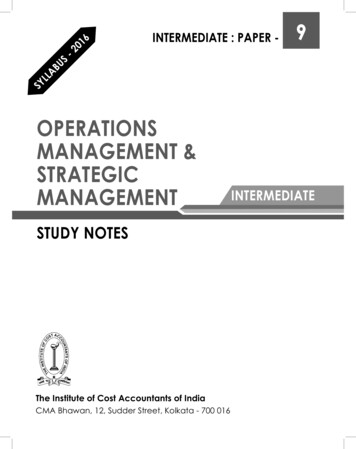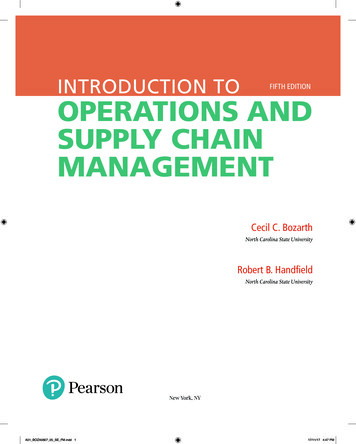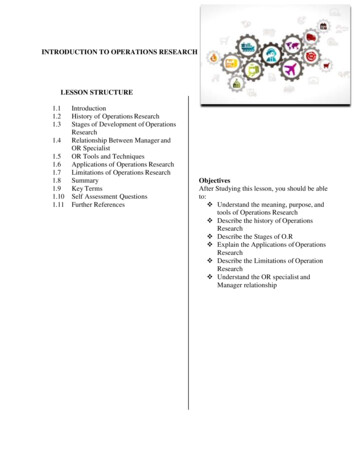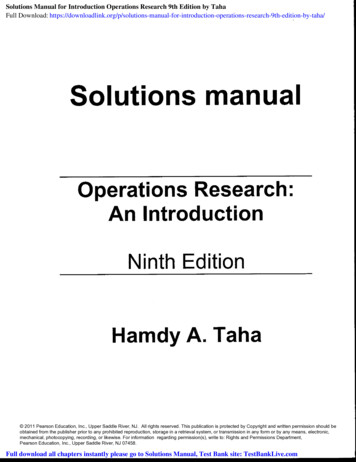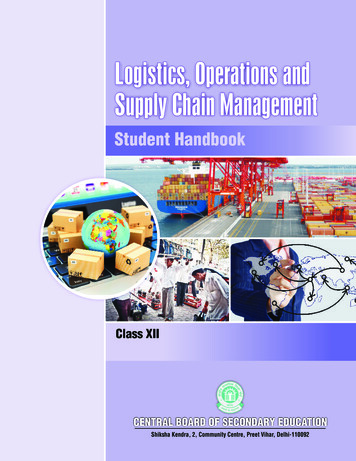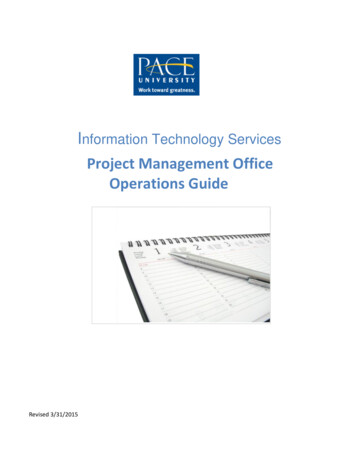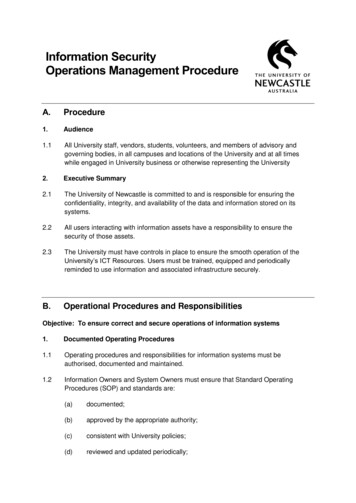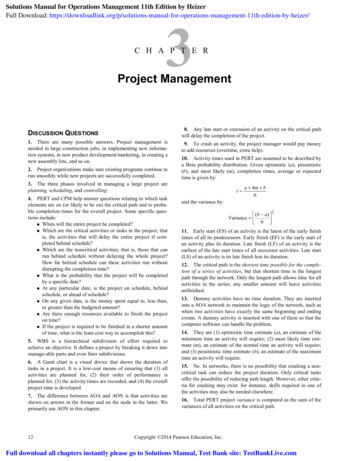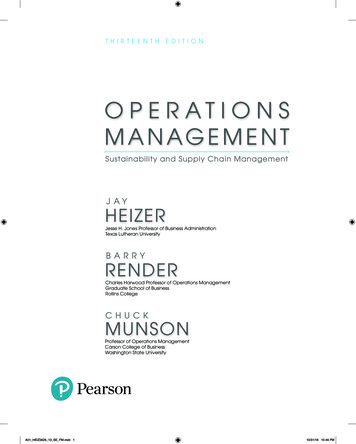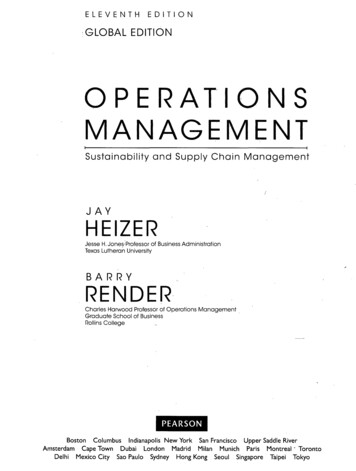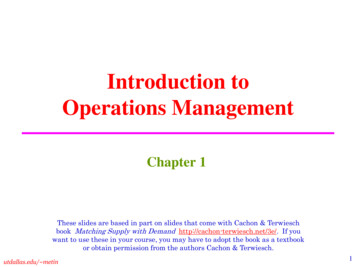
Transcription
Introduction toOperations ManagementChapter 1These slides are based in part on slides that come with Cachon & Terwieschbook Matching Supply with Demand http://cachon-terwiesch.net/3e/. If youwant to use these in your course, you may have to adopt the book as a textbookor obtain permission from the authors Cachon & Terwiesch.utdallas.edu/ metin1
Learning Objectives OperationsManagement Introduction. Manufacturing and Service Operations. How can Operations Management help?utdallas.edu/ metin2
OM Operations Management Management of ANY activities/process that create goods andprovide services» Exemplary Activities: ForecastingScheduling,Quality managementWhy to study OM» Cost and profit breakdownat a typical manufacturing company» How to make more profit? OM Cost 20%MarketingCost 25%Cost cutting.Which costs affect the revenue?» Management of operations iscritical to create and maintaincompetitive advantagesutdallas.edu/ metinProfit 10%ManufacturingCost 45%3
Operations Management Operations management: The management of the efficienttransformation of inputs into outputs to effectively satisfycustomers.The active role of operations:– Inputs become Outputs after some Transformation (Process or Operation)– Food processing example:InputsTransformationOutputsEnergy, Raw vegetablesCleaningClean vegetablesEnergy, Metal sheetsCutting/Rolling/WeldingCansEnergy, VegetablesCutting/ChoppingCut vegetablesEnergy, Water, VegetablesCookingBoiled vegetablesEnergy, Cans, Boiled vegetablesPlacingCan foodutdallas.edu/ metin4
Operations in services:Health careInputsProcessesOutputsDoctors, ical herapySOM offers medical management MBA and Master of ScienceSee http://som.utdallas.edu/amme/index.html.Question: What are Inputs, Processes and Outputs in education?Who is the customer?utdallas.edu/ metin5
Operations are everywhere !OperationsGoods producingExamplesFarming, mining, constructionStorage/transportation Warehousing, trucking, mail, taxis, buses, hotelsExchangeTrade, retailing, wholesaling, renting, leasing, loansEntertainmentRadio, movies, TV, concerts, recordingCommunicationNewspapers, journals, radio, TV, telephones, satelliteutdallas.edu/ metin6
OM at the core of BusinessesOrganizationFinance ThreeOperationsMarketingbasic functions– Operations/Production» Goods oriented (manufacturing and assembly)» Service oriented (health care, transportation and retailing)» Value-added (the essence of the operations functions)– Finance-Accounting» Budgets (plan financial requirements), Provision of funds– MarketingOperations» Selling, Promoting, Assessing customer wants and needsMarketingutdallas.edu/ metinFinance7
Systems (Holistic) Approach Emphasize interrelations among subsystems.A systems approach is essential whenever something is beingdesigned, redesigned, implemented, or improved. It is importantto take into account the impact on all parts of the system.Example: A new feature is added to a product.– Designer must take into account how customers will view the change,instructions for using new feature, the cost, training of workers,production schedule, quality standard, advertising must be informedabout the new feature.– A new feature: Suitcase wheels“The whole is greater thanthe sum of the parts.”utdallas.edu/ metin8
Who has the D(ecision)? Global vs. Local decision makers– How much authority local businesses should have to tailorproducts to the local tastes / market conditions? Center vs. Business unit– Should a parent company have a say in a subsidiary’s capitalinvestment? Function vs. Function– Does product development or marketing decide on the standardfeatures of a car? Inside vs. Outside partners– Should the U.S. apparel manufacturers supervise hiring practicesand monitor working conditions at their foreign suppliers? utdallas.edu/ metinBased on Who has the D? By Rogers and Blenko. HBR January 2006.9
Degree of Standardization ! Standardizedoutput– Take advantage of» standardized methods,» less skilled workers,» standard materials. Example: Iron, Wheat, most of commodities Customizedoutput– Each job is different– Workers must be skilled utdallas.edu/ metinExample: Hair cut, outputs of most service operations.10
Manufacturing vs. Service Operations Productionof goods– Tangible products» Automobiles, Refrigerators, Aircrafts, Coats, Books, Sodas Services– Repairs, Improvements, Transportation, Regulation»»»»»»»utdallas.edu/ metinRegulatory bodies: Government, Judicial system, FAA, FDAEntertainment services: Theaters, Sport activitiesExchange services: Wholesale/retailAppraisal services: Valuation, House appraisalSecurity services: Police force, ArmyEducation: Universities, K-12 schoolsFinancial services: Retail banks, Rating agencies, Investment banks11
Manufacturing vs. Service Operations Differences with respect to1.2.3.4.5.6.7.8.utdallas.edu/ metinCustomer contactUniformity of inputLabor content of jobsUniformity of outputMeasurement of productivityProduction and deliveryQuality assuranceAmount of inventory12
Manufacturing vs. ngibleIntangibleCustomer contactLowHighUniformity of outputHighLowLabor contentLowHighUniformity of inputHighLowMeasurement of productivityEasyDifficultOpportunity to correct quality problemsEasyDifficultAuto RepairAppliancerepairMaid ServiceTeachingManual car wash Lawn mowingSteel productionHome remodelingAutomobile fabricationRetail salesHigh percentage goodsutdallas.edu/ metinLow percentage goods1313
Manufacturing vs. Service Industries in the U.S.utdallas.edu/ metinU.S. Manufacturing vs. Service Employment10080PercentYear Mfg. Service45 792150 722855 722860 683265 643670 643675 584280 444685 435790 356595 326800 307060402004550 556065 707580 859095 00Year14
Responsibilities of Operations Management Planning– Capacity, utilization– Location– Choosing products orservices– Make or buy– Layout– Projects– Scheduling– Market share– Plan for risk reduction,plan B?– Forecasting Controlling– Inventory– Quality– CostsOrganization– Degree of standardization– Subcontracting– Process selectionStaffing– Hiring/lay off– Use of overtime– Incentive plansIn a nutshell, the challenge is“Matching the Supply with Demand”SUPPLY SIDEutdallas.edu/ metinDEMAND SIDE15
Supply Does Not Naturally Match Demand Inventory results from a mismatch between supply and demandMismatch can take one of the following two forms– Supply waits for Demand» Inventory Finished goods and resources– Demand waits for Supply» Inventory is negative or said to be backordered in manufacturing» Inventory Waiting customers in services Mismatch happens because– the demand varies– the capacity is rigid and finite.» If the capacity is infinite, products (or services) can be provided at an infinite rateand instantaneously as the demand happens. Then there is no mismatch.utdallas.edu/ metin16
Consequences of the Mismatch are SevereAir travelEmergency roomRetailingIron ore plantPacemakersSupplySeats on specificflightMedical serviceConsumerelectronicsIron oreMedical equipmentDemandTravel for specifictime and destinationUrgent need formedical serviceConsumers buying anew video systemSteel millsHeart surgeonrequires pacemakerat exact time andlocationSupplyexceedsdemandEmpty seatDoctors, nurses, andinfrastructure areunder-utilizedHigh inventory costs;few inventory turnsPrices fallPacemaker sits ininventoryDemandexceedssupplyOverbooking;customer has to takedifferent flight (profitloss)Crowding and delaysin the ER, potentialdiversion ofambulancesForegone profitopportunity;consumerdissatisfactionPrices riseForegone profit(typically notassociated withmedical risk)Actions tomatch supplyand demandDynamic pricing;booking policiesStaffing to predicteddemand; prioritiesForecasting; quickresponseIf prices fall too low,production facility isshut downDistribution systemholding pacemakersat various locationsManagerialimportanceAbout 30% of allseats fly empty; a 12% increase in seatutilization makesdifference betweenprofits and lossesDelays in treatment ortransfer have beenlinked to death;Per unit inventorycosts for consumerelectronics retailingcommonly exceednet profits.Prices are socompetitive that theprimary emphasis ison reducing thecost of supplyMost products(valued 20k) spend4-5 months waiting ina trunk of a salesperson before beingused17utdallas.edu/ metin17
More Examples of Demand-Supply Mismatch Compaq estimated that it lost 0.5 B to 1 B in sales in 1995 because laptops were notavailable when and where needed In 02-03 flu season, 12 M of 95 M doses of flu vaccines were not used in the US. For 03-04season, 83 95-12 M doses were produced. In 03-04 season, there were widespread vaccineshortages causing flu-related deaths. British Airways had seat utilization of 70.3% in the early 2000s. If it could increaseutilization by 0.33% (by flying one more person on a 300 seat aircraft), it would createadditional revenues equal to quarter 2 profits of 2001, which was 65 M. In 2000, Playstation 2 of Sony were backordered by several weeks due to high demand. ButX-Box of Microsoft did not sell well and was discounted by 100 per unit.– Discounting is a symptom of a problem in operations rather than being a usual practice. In 2009, AT&T’s telecommunication network capacity does not suffice for 3G phone dataflow demands. Calls cannot be made and are dropped.utdallas.edu/ metin18
Who Cares About Inventory in Manufacturing?There is 1.16 trillion ( 1,160,000,000,000) of inventory in the US economy.utdallas.edu/ metin19
The Economic Impact is Worse in Servicesutdallas.edu/ metinIn service, waiting customers are even more important,but this inventory never shows up on the financial records.20
How can OM Help?Step 1: Help Making Operational Trade-OffsResponsivenessHighCall center of Deutche BahnObjective: 80% of incoming calls wait less than 20secondsEarly 2003: 30% of incoming calls wait less than20 secondsProblem: Staffing levels of call centers / impact onefficiencyVery short waiting times,Comes at the expense ofFrequent operator idle timeTradeoffOM Provides tools to balance responsivenesswith efficiencyLowLow laborproductivityLong waiting times,yet operators are almostfully utilizedHigh laborproductivityLabor Productivity(e.g. /call)utdallas.edu/ metin21
How can OM Help?Step 2: Overcome InefficienciesResponsivenessHighCurrent frontierIn the industryCompetitor AEliminateinefficienciesCompetitor CLowCompetitor BLow laborproductivityHigh laborproductivityLabor Productivity(e.g. /call)Example: Benchmarking shows the pattern above Do not just manage the current system Change it!OM Provides tools to identify and eliminate inefficienciesutdallas.edu/ metin22
How can OM Help?Step 3: Evaluate Redesigns/New TechnologiesResponsivenessHighRedesignprocessNew frontierCurrent frontierIn the industryLowLow laborproductivityHigh laborproductivityLabor Productivity(e.g. /call)Example: What will happen if we develop / purchase technology X? Technology X keeps a database of customers and routes them quickly to specialized operators. Better technologies are always (?) nice to have, but will they pay for themselves?OM provides tools to evaluate system designs before implementationutdallas.edu/ metin23
- What are the Tools?- They are the Models Model: A structure which has been built purposefully to exhibitfeatures and characteristics of another object.–––– A map is a model of A toy car is a model of A movie is a model of An OM course is a model of For– Improved understanding and communication» Easy to use, less expensive– Experimentation» Analysis of tradeoffs» Enable “what if” questions– Standardization and organization for analysis»»»» Increase understanding of the problemConsistent toolStandardized formatSpecific objectivesAbstraction vs. computabilityutdallas.edu/ metin24
Types of Models Physicalmodels (prototypes) Schematic models (Graphs, charts, pictures) Mathematical models, by application area» Statistical models Linear regression» Linear programming» Queuing techniques» Inventory models EOQ model» Project management models» Networksutdallas.edu/ metin25
Types of Mathematical Modelsby Employed Technique Simulationmodels : to test a proposed idea– Monte Carlo Simulation Optimization models : to create an optimal idea– Linear programming Pattern recognition models : to recognize a pattern– Statistics, Forecasting, data miningutdallas.edu/ metin26
Summary OperationsManagement Introduction. Manufacturing and Service Operations. How can Operations Management help?utdallas.edu/ metin27
utdallas.edu/ metin 4 Operations Management Operations management: The management of the efficient transformation of inputs into outputs to effectively satisfy customers. The active role of operations: – Inputs become Outputs after some Transfo
